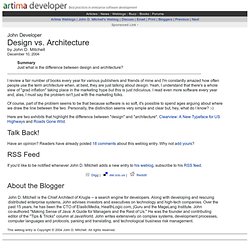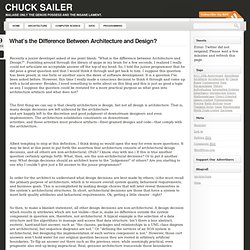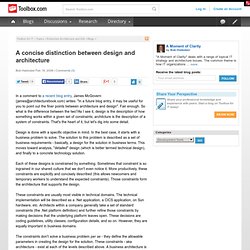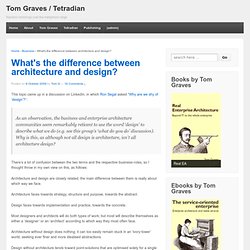

Architecture vs. Design. Design vs. Architecture. John DeveloperDesign vs.

Architectureby John D. MitchellDecember 10, 2004 Summary Just what is the difference between design and architecture? I review a fair number of books every year for various publishers and friends of mine and I'm constantly amazed how often people use the term architecture when, at best, they are just talking about design. Yeah, I understand that there's a whole slew of "grad inflation" taking place in the marketing hype but this is just ridiculous.
Of course, part of the problem seems to be that because software is so soft, it's possible to spend ages arguing about where we draw the line between the two. Difference between design pattern and Architecture. Blog » The Difference between Architecture and Design. My favorite analogy to describe the difference between architecture and design is to use the analogue of highway / street maps.

I you were driving from New York to Los Angeles, you might approach mapping out your route the way we (should) approach architecture and design. At the most abstract level (the architecture), we understand that we have states, cities and within states, and interstate highways. To start, all we really need to know is which states we want to go through, and what interstates we want to take to optimize our time. This is an architectural approach. At this level of abstraction, all interstates can be treated much the same and while we know that the road systems within each city are different, that level of detail is not important (at this point in time).
The differences between architecture and design (design pattern and architecture pattern as well) - Natty Gur. Here's my point of view : there are two main steps while designing a system.

The first one is architecture and the second one id designing. - Architecture : sets which functionality the system should perform, split the functionality between components, set how components should behave and communicate in the system context, set the physical location of components and finally choose the tools in order to create components. - Design : while architecture deals more with the wide picture, design should drill down in to the details relating to implementing certain components. Designing of components end up with classes, interfaces, abstract classes and other OO feature in order to fulfill the given component tasks. What’s the Difference Between Architecture and Design? Recently a junior developer asked of me point blank: "What is the difference between Architecture and Design?

". Fumbling around through the library of quips in my brain for a few seconds, I realized I really could not articulate an acceptable answer off the top of my head. So, I told the junior programmer that he did pose a great question and that I would think it through and get back to him. I suppose this question has been posed, in one form or another since the dawn of software development. It is a question I've been asked before. However, this time I really made a conscious decision to think it through and come up with a lucid answer. Architecture vs. Design. A concise distinction between design and architecture. In a comment to a recent blog entry, James McGovern (james@architecturebook.com) writes: "In a future blog entry, it may be useful for you to point out the finer points between architecture and design".

Fair enough. So what is the difference between the two? Architecture is Objective, Design is Subjective - May 2008. Architecture and design are nearly always bundled together into a single activity.

The individual features of the final architecture are rarely separated into the “objective” or “subjective” aspects. This is a question that I am regularly asked and is often the subject of great debate within the information technology community. My colleague, Simon Watts, recently wrote an article titled “What is I.T.
Architecture?” In which he concluded that architecture is simply the collection of principles and operational requirements that are being applied to a business in order to solve and govern its strategic data processing requirements. Although architecture is a diagram-oriented activity, the diagrams are generally used to present the summary of a set of factual statements and to break a complex problem down into manageable components. Certainly, this conclusion is supported by the major architectural frameworks, such as Zachman and TOGAF, but is, of course, not the full story!
What is the difference between design and architecture. Difference between Architecture and High-level design. What's the difference between architecture and design? This topic came up in a discussion on LinkedIn, in which Ron Segal asked “Why are we shy of ‘design’?

“: As an observation, the business and enterprise architecture communities seem remarkably reticent to use the word ‘design’ to describe what we do (e.g. see this group’s ‘what do you do’ discussion). Why is this, as although not all design is architecture, isn’t all architecture design? There’s a lot of confusion between the two terms and the respective business-roles, so I thought throw in my own view on this, as follows: Is There A Scientific Definition Of "Design"? What is design?

What makes it distinct from art, science, or engineering? The editors of this site decide dozens of times a day what is or isn’t "design. " But is it ultimately subjective, or can it be rigorously defined? Charles Eames offered up a string of impishly oversimplified answers to this question in 1972. Now a pair of Canadian academics have taken the opposite approach: They’ve attempted to formulate analytically a rigorous definition of "the design concept.
" Paul Ralph was preparing his Ph.D. dissertation on "the nature of software design" when his thesis adviser, Yair Wand, suggested that "clearly defining what we meant by design was a good way to begin," Ralph tells Co.Design. Ralph and Wand’s paper is dense reading, but that’s just because they took a serious stab at puncturing common assumptions about what the practice of design is. And in the end, what good is it? Ralph and Wand fully admit that their proposed definition is not, well, definitive. [Read the paper here.] Ralph and-wand-a-proposal-for-a-formal-definition-of-the-design-con... Design Q&A with Charles Eames (1972) Citeseerx.ist.psu.edu/viewdoc/download?doi=10.1.1.232.743&rep=rep1&type=pdf. Www.iso-architecture.org/wicsa2009/Eoin-Woods-WICSA.ECSA-Keynote.pdf. Heim.ifi.uio.no/~petterog/Kurs/INF5220/NatureofTheoryMISQ.pdf.